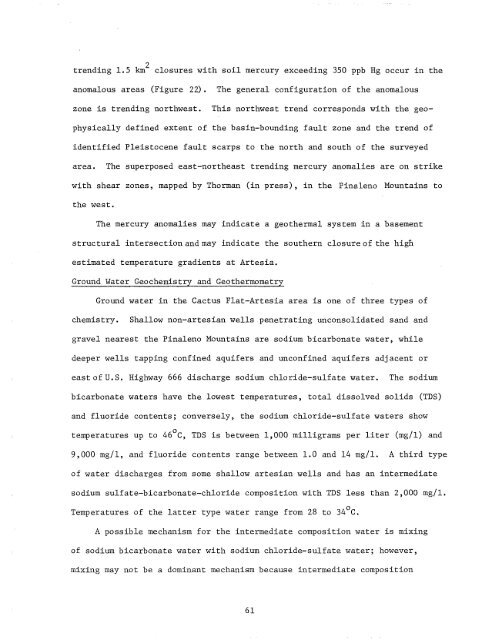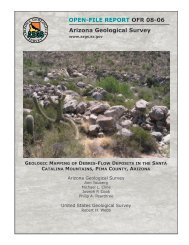geothermal resource potential of the safford-san simon basin, arizona
geothermal resource potential of the safford-san simon basin, arizona
geothermal resource potential of the safford-san simon basin, arizona
Create successful ePaper yourself
Turn your PDF publications into a flip-book with our unique Google optimized e-Paper software.
trending 1.5 km 2 closures with soil mercury exceeding 350 ppb Hg occur in <strong>the</strong><br />
anomalous areas (Figure 22).<br />
zone is trending northwest.<br />
The general configuration <strong>of</strong> <strong>the</strong> anomalous<br />
This northwest trend corresponds with <strong>the</strong> geophysically<br />
defined extent <strong>of</strong> <strong>the</strong> <strong>basin</strong>-bounding fault zone and <strong>the</strong> trend <strong>of</strong><br />
identified Pleistocene fault scarps to <strong>the</strong> north and south <strong>of</strong> <strong>the</strong> surveyed<br />
area.<br />
The superposed east-nor<strong>the</strong>ast trending mercury anomalies are on strike<br />
with shear zones, mapped by Thorman (in press), in <strong>the</strong> Pinaleno Mountains to<br />
<strong>the</strong> west.<br />
The mercury anomalies may indicate a <strong>geo<strong>the</strong>rmal</strong> system in a basement<br />
structural intersection and may indicate <strong>the</strong> sou<strong>the</strong>rn closure <strong>of</strong> <strong>the</strong> hign<br />
estimated temperature gradients at Artesia.<br />
Ground Water Geochemistry and Geo<strong>the</strong>rmometry<br />
Ground water in <strong>the</strong> Cactus Flat-Artesia area is one <strong>of</strong> three types <strong>of</strong><br />
chemistry.<br />
Shallow non-artesian wells penetrating unconsolidated <strong>san</strong>d and<br />
gravel nearest <strong>the</strong> Pinaleno Mountains are sodium bicarbonate water, while<br />
deeper wells tapping confined aquifers and unconfined aquifers adjacent or<br />
east <strong>of</strong> U.S. Highway 666 discharge sodium chloride-sulfate water.<br />
The sodium<br />
bicarbonate waters have <strong>the</strong> lowest temperatures, total dissolved solids (TDS)<br />
and fluoride contents; conversely, <strong>the</strong> sodium chloride-sulfate waters show<br />
temperatures up to 46 o C, TDS is between 1,000 milligrams per liter (mg/l) and<br />
9,000 mg/l, and fluoride contents range between 1.0 and 14 mg/l. A third type<br />
<strong>of</strong> water discharges from some shallow artesian wells and has an intermediate<br />
sodium sulfate-bicarbonate-chloride composition with TDS<br />
o<br />
Temperatures <strong>of</strong> <strong>the</strong> latter type water range from 28 to 34 C.<br />
less than 2,000 mg/l.<br />
A possible mechanism for <strong>the</strong> intermediate composition water is mixing<br />
<strong>of</strong> sodium bicarbonate water with sodium chloride-sulfate water; however,<br />
mixing may not be a dominant mechanism because intermediate composition<br />
61

















